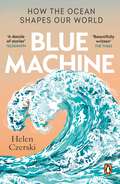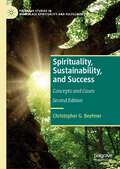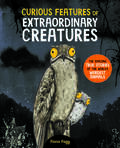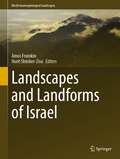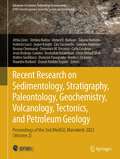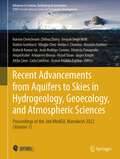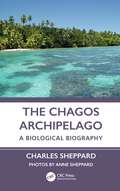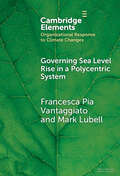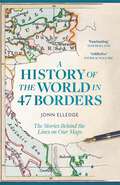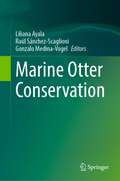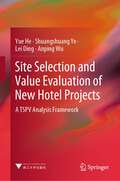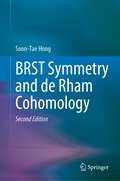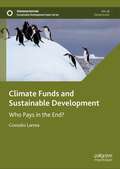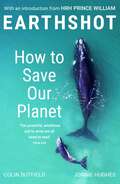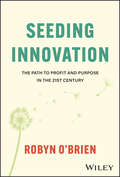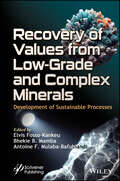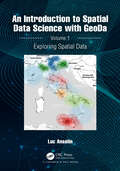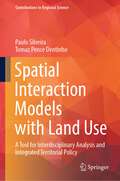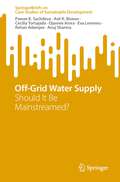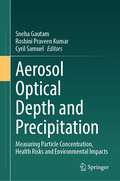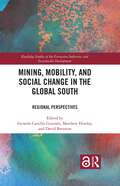- Table View
- List View
Blue Machine: How the Ocean Shapes Our World
by Helen CzerskiFINANCIAL TIMES 2023 HIGHLIGHT'Helen Czerski weaves together physics and biology, history and science, in a beautifully poetic way.'Professor Alice Roberts'In Helen Czerski's hands, the mechanical becomes magical. An instant classic.'Tristan Gooley, author of How to Read Water'Blue Machine is quite simply one of the best books I have ever read.'Dr George McGavin, zoologist, entomologist and broadcaster'A fascinating dive into the essential engine that drives our world. Czerski brings the oceans alive with compelling stories that masterfully navigate this most complex system.'Gaia Vince, science journalist, broadcaster and author of Nomad Century All of the Earth's ocean, from the equator to the poles, is a single engine powered by sunlight - a blue machine.Earth is home to a huge story that is rarely told - that of our ocean. Not the fish or the dolphins, but the massive ocean engine itself: what it does, why it works, and the many ways it has influenced animals, weather and human history & culture.In a book that will recalibrate our view of this defining feature of our planet, physicist Helen Czerski dives deep to illuminate the murky depths of the ocean engine, examining the messengers, passengers and voyagers that live in it, travel over it, and survive because of it. From the ancient Polynesians who navigated the Pacific by reading the waves to permanent residents of the deep such as the Greenland shark that can live for hundreds of years, she explains the vast currents, invisible ocean walls and underwater waterfalls that all have their place in the ocean's complex, interlinked system.Timely, elegant and passionately argued, Blue Machine presents a fresh perspective on what it means to be a citizen of an ocean planet. The understanding it offers is crucial to our future. Drawing on years of experience at the forefront of marine science, Helen Czerski captures the magnitude and subtlety of Earth's defining feature, showing us the thrilling extent to which we are at the mercy of this great engine.
Spirituality, Sustainability, and Success: Concepts and Cases (Palgrave Studies in Workplace Spirituality and Fulfillment)
by Christopher G. BeehnerThis book offers a pragmatic approach to the benefits of spirituality and sustainability for both individual and organizational success. It introduces sustainability and workplace spirituality as contemporary solutions to the challenging organizational environment. The first few chapters introduce the fundamentals of spirituality, workplace spirituality, and sustainability. The author then demonstrates how the three qualities are beneficial in achieving personal and business success. Through the combination of synthesized research summaries and case studies of individuals and organizations, this book offers readers a fresh perspective on the importance of spirituality and sustainability to organizational performance.
Curious Features Of Extraordinary Creatures
by Camilla de BedoyereMeet incredible creatures from all around the world in this colourful, fact-packed animal guide.Curious Features of Extraordinary Creatures tells you all the essential facts about some of the most unique mammals, birds, fish, reptiles and insects that can be found on our planet. Bite-sized text breaks down key information about the creature’s appearance, behaviour and habitat, while colourful and dynamic illustrations bring the animal to life in front of you. Each spread also features bold graphic-novel style panels that tell the story of a key aspect of each animal’s daily life, such as the aye-aye foraging for its dinner and the peacock spider performing a dramatic dance to attract a mate.
Landscapes and Landforms of Israel (World Geomorphological Landscapes)
by Amos Frumkin Nurit Shtober-ZisuThis edited book will bring together a collection of works that comprehensively address the various landforms of Israel and how their evolution has been shaped over time by multiple geomorphic agents. Israel is a small country with highly diverse landscapes and climates; this overview of the most prominent landscapes will describe the processes, origins and the environmental significance of those landscapes. The sites described in this book include lowlands to mountains, the rift valley, and desert to Mediterranean zones, along with long-term interactions between their geomorphology and people, which largely contributed to modern landscapes. The book will be relevant to those interested in the geology, physical geography and history of Israel, and the processes that shaped its unique landscapes.
Recent Research on Sedimentology, Stratigraphy, Paleontology, Geochemistry, Volcanology, Tectonics, and Petroleum Geology: Proceedings of the 2nd MedGU, Marrakesh 2022 (Volume 2) (Advances in Science, Technology & Innovation)
by Attila Çiner Stefano Naitza Ahmed E. Radwan Zakaria Hamimi Federico Lucci Jasper Knight Ciro Cucciniello Santanu Banerjee Hasnaa Chennaoui Domenico M. Doronzo Carla Candeias Jesús Rodrigo-Comino Roohollah Kalatehjari Afroz Ahmad Shah Matteo Gentilucci Dionysia Panagoulia Helder I. Chaminé Maurizio Barbieri Zeynal Abiddin ErgülerThis book is based on the accepted papers for presentation at the 2nd MedGU Annual Meeting, Marrakech 2022. It covers various topics from the fields of (1) sedimentology, stratigraphy, paleontology, (2) geochemistry, mineralogy, petrology, volcanology, (3) structural geology, tectonics, geodynamics, petroleum geology, (4) petroleum and energy sciences and engineering, (5) astrogeology, impact craters and meteorites, and (6) climate and sea level change during the Cenomanian-Turonian Anoxic Event based on a synthesis of sedimentological, micropaleontological, and geochemical records. The content of these papers provides new scientific knowledge based on a series of newest research studies that are relevant to Middle East, Mediterranean region, and Africa.
Recent Advancements from Aquifers to Skies in Hydrogeology, Geoecology, and Atmospheric Sciences: Proceedings of the 2nd MedGU, Marrakesh 2022 (Volume 1) (Advances in Science, Technology & Innovation)
by Haroun Chenchouni Zhihua Zhang Deepak Singh Bisht Matteo Gentilucci Mingjie Chen Helder I. Chaminé Maurizio Barbieri Mahesh Kumar Jat Jesús Rodrigo-Comino Dionysia Panagoulia Amjad Kallel Arkoprovo Biswas Veysel Turan Jasper Knight Attila Çiner Carla Candeias Zeynal Abiddin ErgülerThis book is based on the accepted papers for presentation at the 2nd MedGU Annual Meeting, Marrakesh 2022. It presents a series of newest research studies that are nowadays relevant mainly to Middle East, Mediterranean region, and Africa. It includes major subjects related to hydrology, hydrogeology, hydrogeochemistry including, but not limited to, isotope hydrology, groundwater models, water resources and systems, and related subjects. It also includes research studies on biogeochemistry which mainly focus on the interactions between life and the chemical cycles in the Earth system. Some case studies on geobiology and geoecology investigate the structure and function of geoecosystems, their components, and their environment. The book also presents major subjects related to atmospheric, oceanic, meteorology and climatic science with recent developments in the field. By cutting across these traditional subject boundaries, this book brings together the major elements that are important for understanding the weather, climate, water systems, and geoecosystems in these regions.
The Chagos Archipelago: A Biological Biography
by Charles SheppardThis book is the story of the natural history of Chagos Archipelago, and of the efforts of many to get it recognized as an important and protected wildlife reserve. Exploring its immense natural riches and biodiversity, both on islands and in the marine environment, this book addresses competing claims to its resources, its politics, and the desire of some commercial and political parties to exploit the area. It is about the fight to conserve a wonderland of biodiversity and obtain its protection from exploitation, especially of its reefs and other marine life. This book shows the importance of the Chagos Archipelago and why so much research was done there. Rather than being a typical research book, this work presents research in a narrative form and describes the now substantial Government, UN, and legal interest in the archipelago since the UK was told to ‘decolonise’ it. It is also the story of our planet in miniature: the archipelago encapsulates much of the world’s conservation tribulations in a way we can much more easily understand. This narrative will explore the difficulties faced by the Chagos Archipelago, including displaced people, old and derelict industries (coconut in this case), the military, politics, rich and untouched ecosystems that some want to exploit, ruined habitats on land, climate change, and territorial claims. It will examine how all of these factors have affected the natural history, biodiversity, and conservation of the archipelago. With beautiful photography of the Chagos Archipelago coral reefs and islands, as well as graphs indicating their findings, this book offers professionals, researchers, academics, and students in conservation and biodiversity an insight into one of the world’s most diverse ecosystems. It is also accessible for non‑academic readers with an interest in climate change, biodiversity, and the importance of conservation.
The Chagos Archipelago: A Biological Biography
by Charles SheppardThis book is the story of the natural history of Chagos Archipelago, and of the efforts of many to get it recognized as an important and protected wildlife reserve. Exploring its immense natural riches and biodiversity, both on islands and in the marine environment, this book addresses competing claims to its resources, its politics, and the desire of some commercial and political parties to exploit the area. It is about the fight to conserve a wonderland of biodiversity and obtain its protection from exploitation, especially of its reefs and other marine life. This book shows the importance of the Chagos Archipelago and why so much research was done there. Rather than being a typical research book, this work presents research in a narrative form and describes the now substantial Government, UN, and legal interest in the archipelago since the UK was told to ‘decolonise’ it. It is also the story of our planet in miniature: the archipelago encapsulates much of the world’s conservation tribulations in a way we can much more easily understand. This narrative will explore the difficulties faced by the Chagos Archipelago, including displaced people, old and derelict industries (coconut in this case), the military, politics, rich and untouched ecosystems that some want to exploit, ruined habitats on land, climate change, and territorial claims. It will examine how all of these factors have affected the natural history, biodiversity, and conservation of the archipelago. With beautiful photography of the Chagos Archipelago coral reefs and islands, as well as graphs indicating their findings, this book offers professionals, researchers, academics, and students in conservation and biodiversity an insight into one of the world’s most diverse ecosystems. It is also accessible for non‑academic readers with an interest in climate change, biodiversity, and the importance of conservation.
Governing Sea Level Rise in a Polycentric System: Easier Said than Done (Organizational Response to Climate Change: Businesses, Governments)
by null Francesca Pia Vantaggiato null Mark LubellHow do polycentric governance systems respond to new collective action problems? This Element tackles this question by studying the governance of adaptation to sea level rise in the San Francisco Bay Area of California. Like climate mitigation, climate adaptation has public good characteristics and therefore poses collective action problems of coordination and cooperation. The Element brings together the literature on adaptation planning with the Ecology of Games framework, a theory of polycentricity combining rational choice institutionalism with social network theory, to investigate how policy actors address the collective action problems of climate adaptation: the key barriers to coordination they perceive, the collaborative relationships they form, and their assessment of the quality of the cooperation process in the policy forums they attend. Using both qualitative and quantitative data and analysis, the Element finds that polycentric governance systems can address coordination problems by fostering the emergence of leaders who reduce transaction and information costs. Polycentric systems, however, struggle to address issues of inequality and redistribution.
A Flower Garden for Pollinators: Learn how to sustain and support nature with this practical planting guide
by Rachel de ThameThe perfect guide for any gardener looking for inspiration on how to create a pollinator-friendly garden all year round.Pollinators are essential to life on Earth. Yet bees, butterflies and other beneficial insects are struggling due to climate change and habit loss. Fortunately, what we choose to plant in our gardens can help them to thrive. In this heartfelt guide, horticulturalist and Gardener's World presenter Rachel de Thame highlights plants we can grow that are rich in nectar and pollen, ensuring the garden is filled with beautiful flowers for us all to enjoy year-round.Arranged by season and illustrated with exquisite hand-painted watercolours and glorious photography showcasing many of Rachel's favourite plants, this book provides a captivating look at how best to support nature. Whether you have a small urban courtyard or a large country garden, A Flower Garden for Pollinators will guide your choice of plants, attracting a host of pollinators to your own patch of paradise.'A wonderful journey through the magical world of plants.' - Frances Tophill
A History of the World in 47 Borders: The Stories Behind the Lines on Our Maps
by Jonn Elledge'Fascinating and hugely entertaining' MARINA HYDE'By turns surprising, funny, bleak, ridiculous, or all four of those at once' GIDEON DEFOEPeople have been drawing lines on maps for as long as there have been maps to draw on. Sometimes rooted in physical geography, sometimes entirely arbitrary, these lines might often have looked very different if a war or treaty or the decisions of a handful of tired Europeans had gone a different way. By telling the stories of these borders, we can learn a lot about how political identities are shaped, why the world looks the way it does - and about the scale of human folly.From the Roman attempts to define the boundaries of civilisation, to the secret British-French agreement to carve up the Ottoman Empire during the First World War, to the reason why landlocked Bolivia still maintains a navy, this is a fascinating, witty and surprising look at the history of the world told through its borders.
Marine Otter Conservation
by Liliana Ayala Raúl Sánchez-Scaglioni Gonzalo Medina-VogelThis book offers a multidisciplinary approach to conservation issues related to the marine otter (Lontra felina). The main goal is the systematization of different research efforts on this species, to contribute with conservation policy design and implementation. The authors contribute their achievements in conservation, ecology, status in freshwater habitats, habitat fragmentation effects, interaction with human activities and recommendations for an effective conservation of the species. The book is directed first and foremost towards researchers and authorities and people involved in conservation tasks of otters.Despite in the last decades some studies and efforts on Lontra felina has carried in Peru and Chile, some information can be gathered to fill the gaps on marine otter conservation in Peru. That is the main goal of the book Conservation of Marine Otter. Moreover, the publication will be the first book published at international level on Lontra felina with the participation of several experimented researchers on this threatened and endemic species.
Site Selection and Value Evaluation of New Hotel Projects: A TSPV Analysis Framework
by Yue He Shuangshuang Ye Lei Ding Anping WuThe book constructs a holistic analytical framework for the selection of hotel sites and the evaluation of their value, employing the TSPV (Target Analysis—Site Selection—Project Planning—Value Assessment) methodology, particularly in the context of emerging urban (new area) developments.Proceeding from a theoretical foundation in the TSPV paradigm, the book methodically dissects and examines various components such as factor analysis, market feasibility, and financial scrutiny, pertinent to the process of hotel site selection. It adopts an interdisciplinary approach, integrating these elements, while also addressing the ramifications of uncertainty analysis within the hotel industry.Readers can be navigated through the TSPV framework to engage in a scientifically grounded and logically coherent exploration of critical aspects like site selection, strategic positioning, profitability, and the overall valuation of prospective hotel ventures.
BRST Symmetry and de Rham Cohomology
by Soon-Tae HongThis book provides an advanced introduction to extended theories of quantum field theory and algebraic topology, including Hamiltonian quantization associated with some geometrical constraints, symplectic embedding and Hamilton-Jacobi quantization and Becchi-Rouet-Stora-Tyutin (BRST) symmetry, as well as de Rham cohomology. This extended new edition offers a multifaced insight into phenomenology of particles such as baryons and photons, in terms of extended objects. In particular, in the second edition, the baryons are described in hypersphere soliton model, and the photon properties are additionally included in stringy photon model and in Dirac type relativistic quantum mechanics for a photon.It offers a critical overview of the research in this area and unifies the existing literatures, employing a consistent notation. Although the results presented apply in principle to all alternative quantization schemes, special emphasis is placed on the BRST quantization and its de Rham cohomology group which contribute to a deep understanding of constrained physical theories. The book describes how solitons and other models subject to constraints include rigorous treatments of the geometrical constraints which affect the predictions themselves. The book is intended for use by any graduate-level student with quantum field and relativity theories, and it also serves as a useful reference for those working in the field. An extensive bibliography guides the reader toward the source literature on particular topics.
Climate Funds and Sustainable Development: Who Pays in the End? (Sustainable Development Goals Series)
by Gonzalo LarreaWhile significant attention has been devoted to achieving Sustainable Development Goal 13 (SDG 13) and scaling up climate finance for developing countries, the adverse impacts of funded projects on local communities remains inadequately explored by both academics and policymakers. Mobilizing climate finance on an unprecedented scale is undeniably vital for the success of developing countries’ climate policies. However, these initiatives often give rise to adverse consequences for individuals in these countries, leading to displacements, exacerbating food insecurity, or even triggering conflicts over resources.This book examines the extent to which the climate funds established for achieving SDG 13 are adequate for addressing climate change impacts in developing countries. Yet, its analysis transcends the mere evaluation of the sufficiency or efficacy of these efforts found in much of the existing literature. Beyond the scope of quantifiable success, the book delves into the root causes of the adverse impacts that these funds can have on local communities and offers tailored recommendations to realize the noble aspirations of SDG 13, all without implying that the individuals who should benefit from climate finance are the ones who pay in the end.
Earthshot: How to Save Our Planet
by Colin Butfield Jonnie HughesThe Earthshot concept is simple: Urgency + Optimism = Action. We have ten years to turn the tide on the environmental crisis, but we need the world's best solutions and one shared goal - to save our planet.It's not too late, but we need collective action now. The Earthshots are unifying, ambitious goals for our planet which, if achieved by 2030, will improve life for all of us, for the rest of life on Earth, and for generations to come.They are to:· Protect and Restore Nature· Clean our Air· Revive our Oceans· Build a Waste-Free World· Fix our ClimateEARTHSHOT: HOW TO SAVE OUR PLANET is the first definitive book about how these goals can tackle the environmental crisis, from rainforests to coral reefs, via wilderness, cities and in our own homes. It is a critical contribution to the most important story of the decade.
Seeding Innovation: The Path to Profit and Purpose in the 21st Century
by Robyn O'BrienBuild and grow a company ready for the next generation of consumers In Seeding Innovation: The Path to Profit and Purpose in the 21st Century, veteran entrepreneur, award winning author, global strategist, speaker, and Rice University Innovation and Entrepreneurship professor, Robyn O’Brien, delivers an insightful and data driven roadmap to authenticity and smart leadership in the face of accelerating technological, environmental, and social change. In the book, you’ll discover how to build resilience, authenticity, market share and purpose into your business plan and move beyond box-ticking, virtue signaling and one-dimensional metrics, in a way that strengthens your business model, enhances your bottom line, attracts investors, fortifies employee retention, and more.With her characteristic candor and attention to data and deep experience on the frontlines of industry change, Robyn explains how you can transform concepts like paradigm blindness, scarcity, imposter syndrome, rejection, and fear to build durable, lasting, and profitable businesses that integrate social and environmental principles, with courage and integrity to drive long term shareholder and stakeholder value.You’ll also discover how to: Develop a purpose-driven product line that holds strong appeal for new generations of consumers and avoids the ruthless practices associated with PR nightmares and externalized costs Build an iconic company that focuses on integrating meaningful change to inspire customers, investors, and employees and that eschews meaningless press releases and virtue signaling Overcome imposter syndrome and naysayers using the S.T.O.P. Protocol ™ Develop supportive scaffolding and a resilient mindset in order to leverage courage and gain market share Build boards (not echo chambers), why equity and governance matters, and how diversity is good for your bottom line Integrate authentic marketing and storytelling into your brand strategy to drive revenue and capture market share Avoid the dangers of silos, fundraising traps and toxic capital and build a model with value-aligned, informed investors. Spot greenwashing, gender washing, and carbon washing, and more importantly, how to avoid them within your own organization and drive change Address headlines around ESG and DEI metrics in order to meet the needs of asset managers and investors, build successful teams and integrate goals that are central to outperformance and higher returns Gen Z and the modern consumer are looking for companies with authenticity—they want transparency and purpose from brands that are future proofing for the planet they’re inheriting. With this changing consumer focus and mindset emerges an urgent need for emotionally intelligent leadership. Along with profitability, 21st century leaders must focus on environmental stewardship, equity and justice, employee retention, recruiting, collaboration, and emerging other key aspects of modern business.
Seeding Innovation: The Path to Profit and Purpose in the 21st Century
by Robyn O'BrienBuild and grow a company ready for the next generation of consumers In Seeding Innovation: The Path to Profit and Purpose in the 21st Century, veteran entrepreneur, award winning author, global strategist, speaker, and Rice University Innovation and Entrepreneurship professor, Robyn O’Brien, delivers an insightful and data driven roadmap to authenticity and smart leadership in the face of accelerating technological, environmental, and social change. In the book, you’ll discover how to build resilience, authenticity, market share and purpose into your business plan and move beyond box-ticking, virtue signaling and one-dimensional metrics, in a way that strengthens your business model, enhances your bottom line, attracts investors, fortifies employee retention, and more.With her characteristic candor and attention to data and deep experience on the frontlines of industry change, Robyn explains how you can transform concepts like paradigm blindness, scarcity, imposter syndrome, rejection, and fear to build durable, lasting, and profitable businesses that integrate social and environmental principles, with courage and integrity to drive long term shareholder and stakeholder value.You’ll also discover how to: Develop a purpose-driven product line that holds strong appeal for new generations of consumers and avoids the ruthless practices associated with PR nightmares and externalized costs Build an iconic company that focuses on integrating meaningful change to inspire customers, investors, and employees and that eschews meaningless press releases and virtue signaling Overcome imposter syndrome and naysayers using the S.T.O.P. Protocol ™ Develop supportive scaffolding and a resilient mindset in order to leverage courage and gain market share Build boards (not echo chambers), why equity and governance matters, and how diversity is good for your bottom line Integrate authentic marketing and storytelling into your brand strategy to drive revenue and capture market share Avoid the dangers of silos, fundraising traps and toxic capital and build a model with value-aligned, informed investors. Spot greenwashing, gender washing, and carbon washing, and more importantly, how to avoid them within your own organization and drive change Address headlines around ESG and DEI metrics in order to meet the needs of asset managers and investors, build successful teams and integrate goals that are central to outperformance and higher returns Gen Z and the modern consumer are looking for companies with authenticity—they want transparency and purpose from brands that are future proofing for the planet they’re inheriting. With this changing consumer focus and mindset emerges an urgent need for emotionally intelligent leadership. Along with profitability, 21st century leaders must focus on environmental stewardship, equity and justice, employee retention, recruiting, collaboration, and emerging other key aspects of modern business.
Recovery of Values from Low-Grade and Complex Minerals: Development of Sustainable Processes
by Elvis Fosso-Kankeu Bhekie B. Mamba Antoine F. Mulaba-BafubiandiRecovery of Values from Low-Grade and Complex Minerals The book elaborates on various physicochemical properties of minerals and technological developments to improve the recovery of metals while ensuring cost-effectiveness and minimal environmental impact. The mineral industry is undergoing significant cultural, organizational, and technological transformations to address some of the major limitations and challenges related to the environmental and productivity domains. As far as productivity is concerned, the decrease of high-grade ores has been one of the stumbling blocks toward the achievement of maximum recovery of metals while, on the other hand, the complexity of minerals therein makes it difficult to profitably extract metals using only conventional methods. This book presents eight specialized chapters that focus on the exploration of the complexity of minerals that are likely to negatively influence the recovery of values, as well as the development of adequate technologies capable of improving the process of mineral concentration and/or metal recovery from complex minerals in a sustainable manner. It reviews the various physicochemical properties of minerals that are likely to pose a challenge during the attempt to recover values using conventional methods. It also elaborates on the recent technological development that has been considered by researchers to improve the recovery of metals from gangue-dominated minerals while ensuring cost-effectiveness and minimal adverse environmental impact. Audience This book will be of interest to academic researchers from the fields of mineral processing, hydrometallurgy, geochemistry, environment, chemistry, engineering, and professionals including mining plant operators, environmental managers in the industries, government regulatory bodies officers, and environmentalists.
An Introduction to Spatial Data Science with GeoDa: Volume 1: Exploring Spatial Data
by Luc AnselinThis book is the first in a two-volume series that introduces the field of spatial data science. It offers an accessible overview of the methodology of exploratory spatial data analysis. It also constitutes the definitive user’s guide for the widely adopted GeoDa open-source software for spatial analysis. Leveraging a large number of real-world empirical illustrations, readers will gain an understanding of the main concepts and techniques, using dynamic graphics for thematic mapping, statistical graphing, and, most centrally, the analysis of spatial autocorrelation. Key to this analysis is the concept of local indicators of spatial association, pioneered by the author and recently extended to the analysis of multivariate data.The focus of the book is on intuitive methods to discover interesting patterns in spatial data. It offers a progression from basic data manipulation through description and exploration to the identification of clusters and outliers by means of local spatial autocorrelation analysis. A distinctive approach is to spatialize intrinsically non-spatial methods by means of linking and brushing with a range of map representations, including several that are unique to the GeoDa software. The book also represents the most in-depth treatment of local spatial autocorrelation and its visualization and interpretation by means of GeoDa.The book is intended for readers interested in going beyond simple mapping of geographical data to gain insight into interesting patterns. Some basic familiarity with statistical concepts is assumed, but no previous knowledge of GIS or mapping is required.Key Features:• Includes spatial perspectives on cluster analysis• Focuses on exploring spatial data• Supplemented by extensive support with sample data sets and examples on the GeoDaCenter websiteThis book is both useful as a reference for the software and as a text for students and researchers of spatial data science.Luc Anselin is the Founding Director of the Center for Spatial Data Science at the University of Chicago, where he is also the Stein-Freiler Distinguished Service Professor of Sociology and the College, as well as a member of the Committee on Data Science. He is the creator of the GeoDa software and an active contributor to the PySAL Python open-source software library for spatial analysis. He has written widely on topics dealing with the methodology of spatial data analysis, including his classic 1988 text on Spatial Econometrics. His work has been recognized by many awards, such as his election to the U.S. National Academy of Science and the American Academy of Arts and Science.
An Introduction to Spatial Data Science with GeoDa: Volume 1: Exploring Spatial Data
by Luc AnselinThis book is the first in a two-volume series that introduces the field of spatial data science. It offers an accessible overview of the methodology of exploratory spatial data analysis. It also constitutes the definitive user’s guide for the widely adopted GeoDa open-source software for spatial analysis. Leveraging a large number of real-world empirical illustrations, readers will gain an understanding of the main concepts and techniques, using dynamic graphics for thematic mapping, statistical graphing, and, most centrally, the analysis of spatial autocorrelation. Key to this analysis is the concept of local indicators of spatial association, pioneered by the author and recently extended to the analysis of multivariate data.The focus of the book is on intuitive methods to discover interesting patterns in spatial data. It offers a progression from basic data manipulation through description and exploration to the identification of clusters and outliers by means of local spatial autocorrelation analysis. A distinctive approach is to spatialize intrinsically non-spatial methods by means of linking and brushing with a range of map representations, including several that are unique to the GeoDa software. The book also represents the most in-depth treatment of local spatial autocorrelation and its visualization and interpretation by means of GeoDa.The book is intended for readers interested in going beyond simple mapping of geographical data to gain insight into interesting patterns. Some basic familiarity with statistical concepts is assumed, but no previous knowledge of GIS or mapping is required.Key Features:• Includes spatial perspectives on cluster analysis• Focuses on exploring spatial data• Supplemented by extensive support with sample data sets and examples on the GeoDaCenter websiteThis book is both useful as a reference for the software and as a text for students and researchers of spatial data science.Luc Anselin is the Founding Director of the Center for Spatial Data Science at the University of Chicago, where he is also the Stein-Freiler Distinguished Service Professor of Sociology and the College, as well as a member of the Committee on Data Science. He is the creator of the GeoDa software and an active contributor to the PySAL Python open-source software library for spatial analysis. He has written widely on topics dealing with the methodology of spatial data analysis, including his classic 1988 text on Spatial Econometrics. His work has been recognized by many awards, such as his election to the U.S. National Academy of Science and the American Academy of Arts and Science.
Spatial Interaction Models with Land Use: A Tool for Interdisciplinary Analysis and Integrated Territorial Policy (Contributions to Regional Science)
by Paulo Silveira Tomaz Ponce DentinhoThis book develops spatial interaction models for the analysis of human interaction within space, in terms of both accessibility and land use. Presenting case studies on the Azores and Morocco, it covers applications in various regions of Europe and Africa. The respective models simulate land use, employment, households, commuting and shopping movements and land values, employment distribution for basic activities, changes in accessibility, and changes in land suitability due to climate change.This book will appeal to scholars and students of regional and spatial science, ecological economics, and agricultural economics, as well as to spatial planners and practitioners dealing with issues of spatial planning to address such problems as unsustainable land use, adaptation to climate change, desertification of rural areas heavily dependent on land use, and the impacts of external shocks on land and property values.
Off-Grid Water Supply: Should It Be Mainstreamed? (SpringerBriefs on Case Studies of Sustainable Development)
by Pawan K. Sachdeva Asit K. Biswas Cecilia Tortajada Ojasvee Arora Eva Leneveu Rehan Adamjee Anuj SharmaThis book highlights unique and deeper insights into the operations of off-grid water supply business models and the policy implications that they raise. The two key research questions of the report are as follows: 1) What is the efficacy and sustainability of the off-grid model of safe water availability and/or delivery to consumers who don’t have piped water supply? 2) What are the key policy considerations for planning a successful off-grid model of safe water delivery? Through the Four-Domain Framework, this book does the gap analysis of the physical, operational, financial, and institutional domains of the few off-grid water operators in cross-country case studies. It also includes a detailed financial analysis of the capital costs as well as operations and maintenance costs of the different off-grid water supply models compared to some of the piped water supply models. The final discusses the need to acknowledge off-grid water solutions in urban water policies, especially for the economically weaker sections. The universal coverage of all by the piped water is an ultimate goal of any water policy; however, in the interim, there is a need to put more emphasis on off-grid water solutions.
Aerosol Optical Depth and Precipitation: Measuring Particle Concentration, Health Risks and Environmental Impacts
by Sneha Gautam Cyril Samuel Roshini Praveen KumarThis volume uses aerosol optical depth (AOD) analysis through mapping and remote sensing techniques to derive the relationship between aerosols and hazardous precipitation events, primarily in the form of flooding. Attention is also given to pollution caused by an abundance of particulate matter in the atmosphere and its impacts on human health, which is also assessed via the study of AOD. Background is given on how AOD is retrieved, and why it is a useful tool for estimating atmospheric particle concentration, but also the challenges associated with using this approach. Different aerosol types are introduced to perform a comparative analysis of the most common associations between pollution impacts on temperature and resulting precipitation events. These analyses will help to provide an overview of the best strategies to make informed and sustainable disaster risk management practices and policies. The target audience for the work is students, researchers, and scientists working witha vision towards sustainability, public health safety and air pollution mitigation measures. It will also be a useful text for climate change policy makers, environmental engineers and stakeholders in social development sectors.
Mining, Mobility, and Social Change in the Global South: Regional Perspectives (Routledge Studies of the Extractive Industries and Sustainable Development)
by Gerardo Castillo Guzmán Matthew Himley David BreretonThis volume focuses on how, why, under what conditions, and with what effects people move across space in relation to mining, asking how a focus on spatial mobility can aid scholars and policymakers in understanding the complex relation between mining and social change. This collection centers the concept of mobility to address the diversity of mining-related population movements as well as the agency of people engaged in these movements. This volume opens by introducing both the historical context and conceptual tools for analyzing the mining-mobility nexus, followed by case study chapters focusing on three regions with significant histories of mineral extraction and where mining currently plays an important role in socio-economic life: the Andes, Central and West Africa, and Melanesia. Written by authors with expertise in diverse fields, including anthropology, development studies, geography, and history, case study chapters address areas of both large- and smallscale mining. They explore the historical-geographical factors shaping mining-related mobilities, the meanings people attach to these movements, and the relations between people’s mobility practices and the flows of other things put in motion by mining, including capital, ideas, technologies, and toxic contamination. The result is an important volume that provides fresh insights into the social geographies and spatial politics of extraction. This book will be of great interest to students and scholars of mining and the extractive industries, spatial politics and geography, mobility and migration, development, and the social and environmental dimensions of natural resources more generally.
